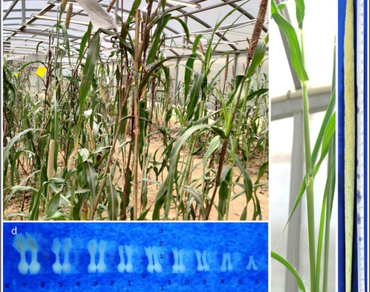Establishment of a correlation between pistil size and female gametophyte developmental stages in apomictic and sexual lines of Cenchrus americanus (L.) Morrone
Singh Heisnam Dinesh, Sharma Monika, Mohapatra Priyanka, Goel Shailendra, Jagannath Arun, Agarwal Manu
Research Articles | Published: 17 February, 2022
First Page: 775
Last Page: 781
Views: 3455
Keywords: Apomixis, Breeding, Female gametophyte, Pistil, Reproduction
Abstract
Apomixis is a unique reproductive strategy that leads to seed production without reductional division and gametic fusion. In order to unravel the regulatory components unique to apomictic lines, apomixis often requires a comparative study between apomictic and its sexual counterpart. Such studies require staging and harvesting of the pistil, which are the apparent choice of tissue for understanding the expression of apomictic trait. The collection and staging of the female tissue require a lot of effort and time, due to which the whole inflorescence is often used instead of harvesting individual pistils. The present study attempts to simplify the procedure of pistil collection by correlating its length with female developmental stages between sexual and apomictic lines of pearl millet. The female development stages in the pistil were confirmed through Differential Interference Contrast microscopy, providing a reliable method for the collection of tissue, saving time and effort. The tissue was kept in liquid nitrogen during collection and later stored at − 80 °C up to a year. The tissue provided excellent quality RNA, which can be used for comparative analysis between sexual and apomictic lines.

References
Dujardin M, Hanna W (1984) Cytogenetics of double cross hybrids between Pennisetum americanum—P. purpureum amphiploids and P. americanum X Pennisetum squamulatum interspecific hybrids. Theor Appl Genet 69:97–100
Goel S, Chen Z, Conner JA, Akiyama Y, Hanna WW, Ozias-akins P (2003) Delineation by fluorescence in situ hybridization of a single hemizygous chromosomal region associated with aposporous embryo sac formation in Pennisetum squamulatum and Cenchrus ciliaris. Genetics 163:1069–1082
Hojsgaard D, Hörandl E (2019) The rise of apomixis in natural plant populations. Front Plant Sci 10:358
Nakano M, Shimada T, Endo T, Fujii H, Nesumi H, Kita M, Ebina M, Shimizu T, Omura M (2012) Characterization of genomic sequence showing strong association with polyembryony among diverse Citrus species and cultivars, and its synteny with Vitis and Populus. Plant Sci 183:131–142
Nogler GA (1984) Gametophytic apomixis. In: Johri BM (ed) Embryology of angiosperms. Springer, Berlin, pp 475–518. https://doi.org/10.1007/978-3-642-69302-1_10
Ozias-akins P, Lubbers EL, Hanna WW, Mcnay JW (1993) Transmission of the apomictic mode of reproduction in Pennisetum: co-inheritance of the trait and molecular markers. Theor Appl Genet 85:632–638. https://doi.org/10.1007/BF00220923
Singh M, Conner JA, Zeng YJ, Hanna WW, Johnson VE, Ozias-akins P (2010) Characterization of apomictic BC7 and BC8 pearl millet: meiotic chromosome behavior and construction of an ASGR-carrier chromosome-specific library. Crop Sci 50:892–902. https://doi.org/10.2135/cropsci2009.05.0263
Van Dijk P, Vijverberg K (2005) The significance of apomixis in the evolution of the angiosperms: a reappraisal. Plant species-level systematics. New perspectives on pattern and process. Regnum vegetabile. Koeltz Scientific Books, Ruggell, pp 101–116. https://doi.org/10.13140/2.1.4567.9042
Author Information
Department of Botany, University of Delhi, Delhi, India